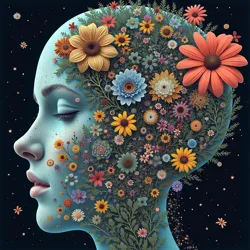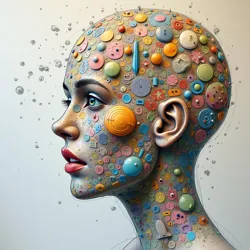The Forefront of Ekphrastic Synaesthesis
 A dynamic visualization showing real-time cross-modal translations in contemporary ekphrastic synaesthetic performance
A dynamic visualization showing real-time cross-modal translations in contemporary ekphrastic synaesthetic performanceFeatured Article: Emergent Patterns in Cross-Modal Translation
Recent breakthroughs in ekphrastic synaesthesis have revealed fascinating patterns in how different sensory modalities interact and influence each other during multi-modal artistic experiences. The Unified Theory of Aesthetic Transfer has proven particularly valuable in understanding these emerging relationships, especially when applied to works that push the boundaries of traditional sensory categories.
A groundbreaking study at the Institute for Experimental Aesthetics has demonstrated that certain emotional responses appear to be consistent across different sensory translations, regardless of the initial input modality. This finding has profound implications for artists working with multi-modal temporal alignment and other advanced techniques in the field.
Innovations in Temporal Synchronization
Recent developments in chronometric calibration systems have enabled unprecedented precision in synchronizing different sensory streams. This has led to new possibilities in creating coherent multi-sensory experiences that maintain their integrity across different perceptual domains. Artists are now able to work with perceptual latency thresholds in ways that were previously impossible, creating seamless transitions between different sensory modalities.
 Advanced sensory translation array used in contemporary ekphrastic synaesthetic performances
Advanced sensory translation array used in contemporary ekphrastic synaesthetic performancesCurrent Research Highlights
Advances in Pain-Music Synthesis
Building on the controversial success of Baroque Grindcore Fugue in Pain Major, researchers have made significant progress in understanding the relationship between musical structure and nociception. New studies in musical nociception theory have revealed previously unknown connections between harmonic intervals and specific pain responses, leading to more nuanced applications of neural-haptic pain synthesis in artistic works.
Chemical-Auditory Breakthroughs
Recent experiments with sono-reactive compounds have yielded exciting new possibilities for creating direct chemical responses to sound. These developments have enhanced works like Taste the Thunder's Violet, allowing for more precise control over gustatory and olfactory elements in multi-sensory compositions.
Innovation in Narrative Integration
The success of The Noir Verses has sparked renewed interest in narrative-driven ekphrastic synaesthetic works. Artists are exploring new ways to incorporate storytelling elements while maintaining the intense sensory integration that characterizes the medium. The pain modulation matrix has proven particularly effective in creating emotionally resonant narrative experiences.
Current Projects and Installations
The Crystalline Whispers of Dawn
Artist #D34DB33F's latest installation combines morning dew collection systems with hydroacoustic resonance chambers to create an evolving composition that translates the process of water evaporation into both sound and tactile sensation. The work employs sophisticated environmental monitoring systems to create a feedback loop between atmospheric conditions and artistic output.
Synaptic Symphony No. 1 in Umami
Building on principles established in the Manifesto of Sensory Transcendence, artist #F00D13E has created a revolutionary work that maps classical orchestral structures onto gustatory experience. The piece employs neural-haptic interfaces to create direct connections between musical phrases and taste receptor activation patterns.
Technological Developments
Advanced Sensory Integration Systems
Recent advances in neural interface technology have enabled more precise control over cross-modal sensory experiences. New developments in bioelectric feedback systems allow for real-time adjustment of sensory parameters based on participant responses.
Environmental Control Innovations
The development of more sophisticated atmospheric composition control systems has enabled artists to create more precisely controlled environments for their works. These systems allow for fine-tuned manipulation of temperature, humidity, air pressure, and chemical composition of the atmosphere within installation spaces.
Educational Initiatives
New Academic Programs
Several major institutions have recently established dedicated programs in ekphrastic synaesthetic arts. The Academy of Multi-Modal Arts has launched a comprehensive curriculum focusing on both technical and theoretical aspects of the field.
Workshop Series
The International Workshop for Synaesthetic Creation continues to provide valuable opportunities for artists to experiment with new techniques and technologies. Recent workshops have focused on advanced applications of sensory translation matrices and neural plasticity induction.
Future Directions
Emerging Technologies
Current research focuses on developing more sophisticated neural interface systems and environmental control mechanisms. These developments promise to enable even more precise control over cross-modal experiences.
Theoretical Developments
Ongoing work in aesthetic information theory and cross-modal mapping continues to provide new frameworks for understanding and creating ekphrastic synaesthetic works.
Notable Upcoming Events
-
The Annual Symposium on Multi-Modal Arts will feature demonstrations of several groundbreaking new works
-
The International Conference on Synaesthetic Creation will focus on recent technological innovations
-
The Exhibition of Temporal-Spatial Integration will showcase new works exploring the relationship between time, space, and sensory experience
Research Opportunities
Current Areas of Investigation
Researchers are currently exploring new applications of quantum sensing technology and advanced neural interfaces in ekphrastic synaesthetic works. These investigations promise to expand the possibilities for creating more sophisticated and nuanced multi-sensory experiences.
Collaborative Projects
Several major institutions are currently seeking participants for studies involving new sensory translation techniques and environmental response systems. These projects offer opportunities for both artists and researchers to contribute to the development of the field.
Resources
The field maintains several important repositories of information and technical documentation:
-
The Journal of Multi-Modal Arts continues to publish cutting-edge research and theoretical work
-
The Technical Database of Synaesthetic Creation provides detailed information about current technologies and techniques
-
The Archive of Historical Synaesthetic Works preserves documentation of significant pieces in the field's development